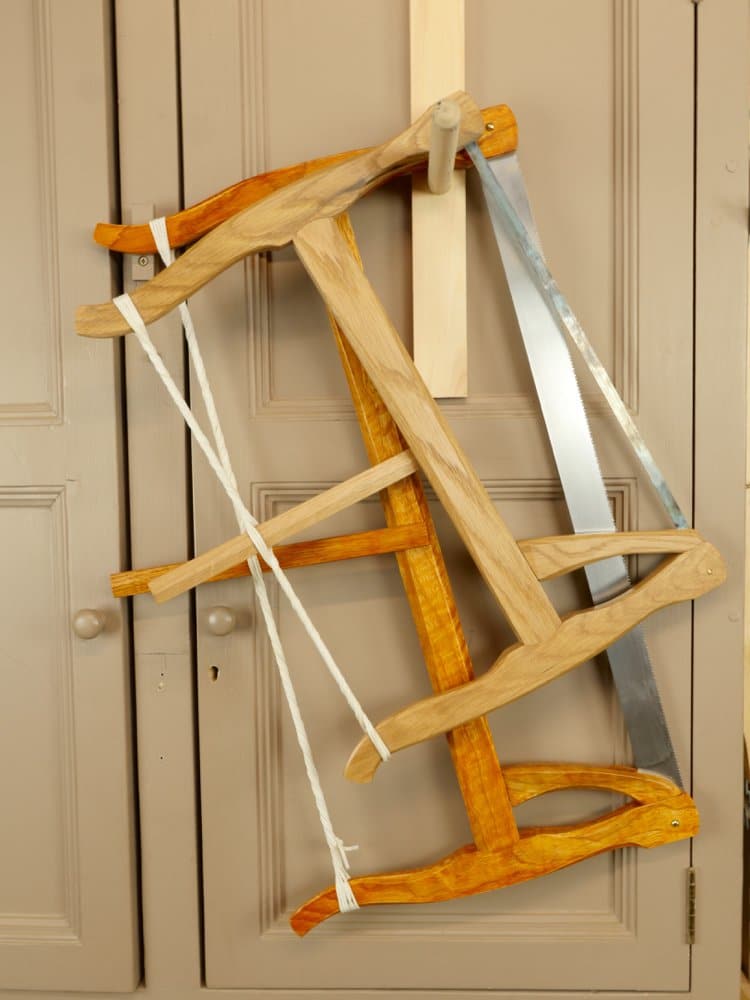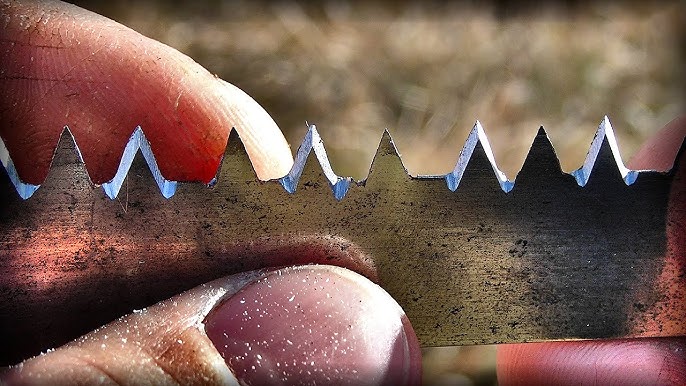Sharpening a bow saw is essential for maintaining its efficiency. A sharp saw cuts better and lasts longer.
A bow saw is a versatile tool used for cutting wood. Over time, its teeth can become dull, making the job harder. Learning to sharpen your bow saw can save you time and effort. It also ensures cleaner cuts and prolongs the saw’s life.
Whether you’re an avid gardener or a DIY enthusiast, knowing this skill is valuable. In this guide, we will explore the steps to keep your bow saw in top shape. From gathering the right tools to mastering the technique, you’ll find everything you need here. Let’s dive into the process of sharpening a bow saw effectively.
Choosing The Right Tools
Choosing the right tools is vital for sharpening a bow saw. The correct tools make the process easier and ensure a sharp blade. Here, we discuss the essential tools and equipment needed.
File Types
Different files suit different tasks. For sharpening a bow saw, the following file types are crucial:
| File Type | Usage |
|---|---|
| Triangular File | Perfect for crosscut saw teeth. |
| Round File | Ideal for gullets between teeth. |
| Flat File | Used for straightening edges. |
Additional Equipment
Besides files, other equipment makes the sharpening process efficient:
- Saw Vise: Holds the saw blade steady.
- Saw Set: Adjusts the teeth’s angle.
- Ruler: Measures the teeth alignment.
- Marker: Marks the teeth to track progress.
Using these tools ensures a sharp, efficient bow saw. Proper tools and equipment make the job easier and faster.
Safety Precautions
Sharpening a bow saw is essential for maintaining its efficiency. But safety should be your top priority. Follow these safety precautions to ensure a smooth and injury-free sharpening process.
Protective Gear
Wearing the right protective gear is crucial. It minimizes the risk of injury. Make sure to wear:
- Safety glasses to protect your eyes from metal shavings.
- Gloves to protect your hands from sharp edges.
- Ear protection if you’re using noisy tools.
Proper Workspace
Setting up a proper workspace is vital. It ensures your safety and efficiency. Follow these steps:
- Choose a well-lit area. Good lighting helps you see the saw blade clearly.
- Clear the workspace. Remove any clutter or obstacles.
- Use a stable surface. A sturdy table or workbench is ideal.
- Secure the saw blade. Use a clamp to keep it in place while sharpening.
Following these safety precautions will help you sharpen your bow saw safely. Always prioritize your safety.
Preparing The Saw
Before sharpening a bow saw, proper preparation is essential. This ensures the sharpening process is smooth and effective. The following steps will guide you through the preparation phase.
Securing The Saw
First, secure the saw in a stable position. Use a vice or clamps to hold it firmly. This prevents any movement during sharpening. A stable saw ensures precise and safe sharpening.
Cleaning The Blade
Next, clean the blade thoroughly. Dirt and rust can hinder the sharpening process. Use a wire brush or a cloth to remove any debris. For stubborn rust, apply a rust remover. Ensure the blade is completely clean before proceeding.

Credit: troop317.pbworks.com
Filing The Teeth
Sharpening your bow saw is crucial for smooth cuts and efficient work. A key step in this process is filing the teeth. This ensures each tooth is sharp and ready for action. Here’s how you can do it.
Starting Point
First, secure your bow saw in a vice. This will keep it steady. Make sure the teeth face upwards. Identify the starting point by locating the first tooth. It’s essential to start at one end and move to the other.
Filing Technique
Hold the file at a 45-degree angle. Position it to match the tooth’s bevel. Push the file forward with even pressure. Avoid filing on the return stroke. Repeat this three to four times for each tooth.
Ensure you maintain the same angle for every tooth. This consistency is key for effective cutting. Use a marker to keep track of filed teeth. This prevents missing any teeth and ensures uniform sharpness.
Once done, check the teeth for sharpness. They should be shiny and feel sharp to the touch. If some teeth still seem dull, repeat the filing process.
Setting The Teeth
Sharpening a bow saw is important for maintaining its efficiency. One crucial step in this process is setting the teeth. Properly set teeth ensure the saw cuts smoothly and efficiently. This section will guide you through the process of setting the teeth.
Using A Saw Set
A saw set is a tool specifically designed for this task. Start by clamping the saw blade in a vise. Ensure the teeth are facing upwards. Place the saw set on the first tooth. Squeeze the handle to bend the tooth slightly. Alternate the teeth as you go along the blade. This ensures an even cut.
Adjusting Tooth Angle
Adjusting the tooth angle is essential for effective cutting. A standard angle is around 15 degrees. Use a protractor or a saw sharpening guide. Set each tooth to the desired angle. Check the alignment regularly to maintain consistency.

Credit: paulsellers.com
Testing Sharpness
Testing the sharpness of your bow saw is essential. It ensures the saw is ready for use. A sharp saw makes work easier and safer. You can test the sharpness through visual inspection and a cutting test.
Visual Inspection
Begin with a close look at the teeth of the saw. Sharp teeth should have clean, defined edges. They should reflect light evenly. Dull teeth appear rounded or chipped. Inspect the saw blade under good lighting.
Check for any rust or debris. These can affect sharpness. A clean blade performs better. Use a magnifying glass if needed. This helps to see fine details clearly.
Cutting Test
Next, perform a simple cutting test. Find a piece of wood similar to what you usually cut. Start sawing with light pressure. A sharp saw will cut smoothly and quickly. It should create fine sawdust.
If the saw struggles or binds, it may need more sharpening. Listen to the sound as you cut. A sharp saw has a clean, consistent sound. A dull saw sounds rough and uneven. This test confirms if your saw is ready for use.
Maintenance Tips
Maintaining your bow saw ensures it remains sharp and effective. Regular maintenance prevents rust and prolongs the lifespan of your tool. Below are some essential maintenance tips to keep your bow saw in top condition.
Regular Cleaning
Always clean your bow saw after each use. Wipe off any sap, dirt, or moisture with a dry cloth. This prevents rust and keeps the blade sharp. Use a wire brush for stubborn residue. Ensure the blade is completely dry before storing.
Proper Storage
Store your bow saw in a dry place. Moisture can cause rust and dull the blade. Use a protective cover if available. Hang the saw to avoid any damage to the teeth. Keep it away from children and pets for safety.
Common Mistakes
Sharpening a bow saw is essential for maintaining its efficiency. However, many people make common mistakes that can damage the tool or lead to unsafe conditions. Being aware of these mistakes can help you avoid them and keep your bow saw in good shape.
Over-filing
Over-filing the teeth is a frequent mistake. This happens when you remove too much material from the teeth. Over-filing can weaken the teeth. This makes them more likely to break. Always file just enough to sharpen the teeth. Check the teeth often to see your progress. This prevents over-filing.
Ignoring Safety
Ignoring safety is another common mistake. Many people do not use protective gear. Always wear gloves to protect your hands. Safety glasses are also important. They protect your eyes from flying metal shavings. Keep a firm grip on the saw. It can slip if not held properly. Secure the saw in a vise. This keeps it steady while you work. Safety should always be your top priority.

Credit: www.youtube.com
Frequently Asked Questions
How Often Should I Sharpen A Bow Saw?
Sharpen your bow saw after every 3-4 hours of use. Regular maintenance ensures efficient cutting and prolongs the blade’s life.
What Tools Are Needed To Sharpen A Bow Saw?
You’ll need a flat file, a triangular file, and a saw set. These tools help restore the teeth to their optimal condition.
Can I Sharpen A Bow Saw Myself?
Yes, you can sharpen a bow saw yourself. Follow a step-by-step guide and use the right tools for best results.
How Do I Know If My Bow Saw Is Dull?
A dull bow saw requires more effort to cut and produces rough, uneven cuts. Regular inspection helps identify dullness early.
Conclusion
Sharpening a bow saw is simple with the right steps. Regular maintenance keeps your saw effective. Follow the guide, and your bow saw will stay sharp. A sharp saw makes cutting easier and faster. Always wear safety gear when sharpening.
Practice these steps and enjoy smooth, clean cuts every time. Happy sawing!
